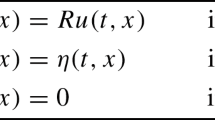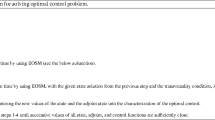Abstract
In this paper, a novel numerical algorithm is presented to compute the optimal time of a time optimal control problem where the governing system is a linear ordinary differential equation. By the equivalence between time optimal control problem and norm optimal control problem, computation of the optimal time can be obtained by solving a sequence of norm optimal control problems, which are transferred into their Lagrangian dual problems. The nonsmooth structure of the dual problem is approximated by the iteratively reweighted least square strategy. Several numerical tests are given to show the efficiency of the proposed algorithm.



Similar content being viewed by others
References
Barbu, V.: Analysis and Control of Nonlinear Infinite Dimensional Systems. Academic Press, Boston (1993)
Chen, X.: Smoothing methods for nonsmooth, nonconvex minimization. Math. Program. 134, 71–99 (2012)
Daubechies, I., Defrise, M., De Mol, C.: An iterative thresholding algorithm for linear inverse problems with a sparsity constraint. Commun. Pure Appl. Math. 57, 1413–1457 (2004)
Daubechies, I., DeVore, R., Fornasier, M., Güntürk, C.S.: Iteratively reweighted least squares minimization for sparse recovery. Commun. Pure Appl. Math. 63, 1–38 (2010)
Eckstein, J., Bertsekas, D.P.: On the Douglas–Rachford splitting method and the proximal point algorithm for maximal monotone operators. Math. Program. 55, 293–318 (1992)
Evans, L.C.: An Introduction to Mathematical Optimal Control Theory. Lecture Notes, Department of Mathematics, University of California, Berkeley (2008)
Fattorini, H.O.: Infinite Dimensional Linear Control Systems, the Time Optimal and Norm Optimal Control Problems, vol. 201. Elsevier, Amsterdam (2005)
Hermes, H., LaSalle, J.: Functional Analysis and Time Optimal Control. Academic Press, New York (1969)
Hintermüller, M., Ito, K., Kunisch, K.: The primal-dual active set strategy as a semismooth Newton method. SIAM J. Optim. 13, 865–888 (2002)
Ito, K., Kunisch, K.: Semismooth newton methods for time-optimal control for a class of ODES. SIAM J. Control Optim. 48, 3997–4013 (2010)
Kaya, C.Y., Noakes, J.L.: Computations and time-optimal controls. Optim. Control Appl. Methods 17, 171–185 (1996)
Kaya, C.Y., Noakes, J.L.: Computational methods for time-optimal switching controls. J. Optim.Theory Appl 117, 69–92 (2003)
Kunisch, K., Wang, L.: Time optimal control of the heat equation with pointwise control constraints. ESAIM Control Optim. Calc. Var. 19, 460–485 (2013)
Lasalle, J.P.: The Time Optimal Control Problem, Contributions to the Theory of Nonlinear Oscillations, vol. 5, pp. 1–24. Princeton University Press, Princeton (1960)
Li, X., Yong, J.: Optimal Control Theory for Infinite Dimensional Systems. Birkhäuser, Boston (1995)
Meier, E., Bryson, A.E.: Efficient algorithms for time-optimal rigid spacecraft reorientation problem. J. Guid. Control Dyn. 13, 859–866 (1990)
Pontryagin, L.S., Boltyanskii, V.G., Gamkrelidze, R.V., Mishchenko, E.F.: The Mathematical Theory of Optimal Processes. Interscience Publishers, New York (1962)
Quarteroni, A., Sacco, R., Saleri, F.: Numerical Mathematics. Springer, Berlin (2000)
Sontag, E.D.: Mathematical Control Theory: Deterministic Finite Dimensional Systems. Springer, New York (1998)
Wang, G., Zheng, G.: An approach to the optimal time for a time optimal control problem of an internally controlled heat equation. SIAM J. Control Optim. 50, 601–628 (2012)
Wang, G., Zuazua, E.: On the equivalence of minimal time and minimal norm controls for internally controlled heat equations. SIAM J. Control Optim. 50, 2938–2958 (2012)
Xu, S.: The Compution of Matrices in Control Theorey (in Chinese). China Higher Education Press, Beijing (2011)
Yong, J., Lou, H.: A Concise Course Of Optimal Control Theory. China Higher Education Press, Beijing (2006). (in Chinese)
Zhang, C.: The time optimal control with constraints of the rectangular type for linear time-varying ODEs. SIAM J. Control Optim. 51, 1528–1542 (2013)
Zuazua, E.: Controllability and observability of partial differential equations: some results and open problems. In: Dafermos, C.M., Feireisl, E. (eds.) Handbook of Differential Equations: Evolutionary Equations, vol. 3, pp. 527–621. Elsevier, Amsterdam (2006)
Acknowledgements
The authors would like to thank the referees for their valuable comments, and to thank Professor Kunisch Karl and Professor Gengsheng Wang for their interesting inputs. The work of X. Lu was partially supported by the National Natural Science Foundation of China under Grants Nos. 11471253 and 91630313, and the work of L. Wang was partially supported by the National Natural Science Foundation of China under Grant No. 11371285.
Author information
Authors and Affiliations
Corresponding author
Appendix
Appendix
Proof of Lemma 1
The proof is divided into four steps as follows.
Step 1.
It can be proved by contradiction. Assume that \(B^\mathrm {T}\varphi (t;T,\mu )= 0\) at infinite \(t\in [0,T]\). Since \(B^\mathrm {T}\varphi (t;T,\mu )\) is analytic, we then obtain \(B^\mathrm {T}\varphi (t;T,\mu )\equiv 0\) in [0, T], which implies that
From \((H_2)\) and (28), it follows that
which leads to a contradiction.
Step 2. The bang-bang property of \((TP)^M\).
By Pontryagin’s maximum principle (see Theorem 3.5 in Chapter 3 of [24]), there exists \(\xi \in {\mathbb {R}}^n\) with \(\Vert \xi \Vert =1\) such that
This, together with (27), indicates the bang-bang property of \((TP)^M\). Then the uniqueness of the optimal control follows.
Step 3. For any \(\tau \in (0,T)\), there exists a generic positive constant \(C(\tau )\) dependent on \(\tau \), such that
It can be proved by contradiction. Assume that there exists \(\mu _\ell \in {\mathbb {R}}^n\) with \(\Vert \mu _\ell \Vert =1\) and
Since \(\Vert \mu _\ell \Vert =1\), there exists a subsequence of \(\{\mu _\ell \}_{\ell \ge 1}\), still denoted by \(\{\mu _\ell \}\), and \(\mu _0\in {\mathbb {R}}^n\), such that
Passing to the limit for \(\ell \rightarrow +\infty \) in (30), we have that
This implies that \(B^\mathrm {T}\varphi (t;\tau ,\mu _0)=0\) for a.e. \(\; t\in [0,T]\) and contradicts (27).
Step 4. By (29) and the equivalence between the observability and controllability, see e.g. Theorem 2.1 in [19], we get that for any \(z_0\in {\mathbb {R}}^n\), there exists a control \(u\in L^\infty (0,\tau ;{\mathbb {R}}^m)\) with
such that the solution \(z(\cdot )\) to the equation
satisfies that \(z(\tau )=0\).
By (31) and using the same argument as in [22], we have that (ii), (iii) and (iv) hold. Finally, the bang-bang property and the uniqueness of the optimal control for \((NP)^T\) follow from (iv) and Step 2. \(\square \)
Proof of Proposition 1
By changing variables, it suffices to show that there exists a solution \((T,y(\cdot ),u(\cdot ),\psi (\cdot ))\) to the the following system
where T is the optimal time to \((TP)^M\) and \(u(\cdot )\), when extended by zero to \((T, +\infty )\), is the optimal control to \((TP)^M\).
On one hand, let \(y^*(\cdot )\) and \(u^*(\cdot )\) be the optimal state and optimal control to \((TP)^M\), respectively and let \(\mu ^*\) be a minimizer of \(J^{t^*(M)}(\cdot )\). By (iv) in Lemma 1 and (iii) in Lemma 2, we have that
is a solution to (32). On the other hand, for any solution \(( T, y(\cdot ), u(\cdot ), \psi (\cdot ))\) to (32) and any \(\nu \in {\mathbb {R}}^n\), multiplying the first equation of (32) by \(\varphi (\cdot ;T,\nu )\) and integrating it over (0, T), we get that
This, together with (ii) in Lemma 2, indicates that
It follows from the third equality, the fourth equality in (32), (33) and (iii) in Lemma 2 that
By the third equality in (32) and (34), we obtain that \(M=M^*(T)\), which, combined with (iii) and (iv) in Lemma 1, implies
From this equation, (34) and (iv) in Lemma 1, we obtain the conclusion. \(\square \)
Proof of Lemma 2
(i) It is obvious that \(J_\varepsilon ^T(\cdot )\) is continuous and convex. By (29), we have that
We will prove
by contradiction, and the coercivity follows immediately. Assume that there exist \(\{\mu _k\}\subset {\mathbb {R}}^n\) and a positive constant C which is independent of k, such that \(\Vert \mu _k\Vert \rightarrow +\infty \) and
Let \(\displaystyle v_k\triangleq \frac{\mu _k}{\Vert \mu _k\Vert }\), then there exists a subsequence of \(\{v_k\}_{k\ge 1}\), still denoted by the same way, and \(v_0\in {\mathbb {R}}^n\) with \(\Vert v_0\Vert =1\) and \(v_k\rightarrow v_0\). From (37), it follows that
Passing to the limit for \(k\rightarrow \infty \) in the above inequality, we get that
This implies that \(v_0=0\), which leads to a contradiction. By the continuity and the coercivity of \(J_\varepsilon ^T(\cdot )\), there exists a minimizer \(\mu _\varepsilon ^*\).
Next we prove that \(\mu _\varepsilon ^*\ne 0\). If not, we have that for any \(\mu \in {\mathbb {R}}^n\),
and
From the above two inequalities, we obtain that
Letting \(\lambda \rightarrow 0^+\), we obtain that
i.e.,
This implies \(\Vert e^{-AT}y_0\Vert \le \varepsilon \), which contradicts \(T<T_\varepsilon ^*\).
(ii) On one hand, if \(\mu _\varepsilon ^*\) is a minimizer of \(J_\varepsilon ^T(\cdot )\), we have that
Letting \(\lambda \rightarrow 0^+\) in the above inequality, one can check that (5) holds. On the other hand, since \(J_\varepsilon ^T(\cdot )\) is convex and the minimizer is nonzero, then \(\nabla J_\varepsilon ^T(\mu _\varepsilon ^*) =0\) (which is equation (5)) implies \(\mu _\varepsilon ^*\ne 0\) is a minimizer of \(J_\varepsilon ^T(\cdot )\).
(iii) Let \(\mu _\varepsilon ^*\) be a minimizer of \(J_\varepsilon ^T(\cdot )\) and \(u_\varepsilon ^*\) be defined by (6). First, we can prove that \(u_\varepsilon ^*\) is an admissible control for \((NP)_\varepsilon ^T\). Let \(y(\cdot )\) be the solution to
Multiplying the first equation of the above system by \(\varphi (\cdot ;T,\nu )\) and integrating it over (0, T), we get that
From the latter and (6) it follows that
which, combined with (5), indicates that
This implies \(\Vert y(T)\Vert \le \varepsilon \) and \(u_\varepsilon ^*\) is an admissible control for \((NP)_\varepsilon ^T\).
Then, we prove that \(u_\varepsilon ^*\) is an optimal control for \((NP)_\varepsilon ^T\). For any \(u\in L^\infty (0,+\infty ;{\mathbb {R}}^m)\) satisfying that
multiplying the first equation of the above system by \(\varphi (\cdot ;T,\mu _\varepsilon ^*)\) and integrating it over (0, T), we get that
This, together with (5), implies that
Since \(\Vert h(T)\Vert \le \varepsilon \), it follows from the latter equality that
Thus
This shows that \(u_\varepsilon ^*\) is an optimal control to \((NP)_\varepsilon ^T\) and
\(\square \)
Proof of Proposition 2
Let \(0<\varepsilon <\Vert y_0\Vert \) and \(0<T<T_\varepsilon ^*\). For any \(\mu _1,\,\mu _2\in {\mathbb {R}}^n\), \(0<\alpha <1\), we have that
First, we notice that the first inequality in (38) becomes equality if and only if there exists a constant \(k\ge 0\) and a function \(\beta (\cdot ):\,[0,T]\rightarrow [0,+\infty )\), such that
These imply that the first inequality in (38) becomes equality if and only if there exists a constant \(k\ge 0\), such that
Then, the second inequality in (38) becomes equality if and only if
Hence \(J_\varepsilon ^T(\alpha \mu _1+(1-\alpha )\mu _2)=\alpha J_\varepsilon ^T( \mu _1)+(1-\alpha )J_\varepsilon ^T( \mu _2)\) if and only if \(\mu _1=\mu _2\). This shows that \(J_\varepsilon ^T(\cdot )\) is strictly convex and it has a unique minimizer. \(\square \)
Rights and permissions
About this article
Cite this article
Lu, X., Wang, L. & Yan, Q. Computation of Time Optimal Control Problems Governed by Linear Ordinary Differential Equations. J Sci Comput 73, 1–25 (2017). https://doi.org/10.1007/s10915-017-0403-1
Received:
Revised:
Accepted:
Published:
Issue Date:
DOI: https://doi.org/10.1007/s10915-017-0403-1
Keywords
- Time optimal control
- Norm optimal control
- Ordinary differential equation
- Bisection method
- Iteratively reweighted least square




